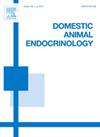使用酪氨酸羟化酶抑制剂(α-甲基-para-酪氨酸)短期减少健康马体内多巴胺的生理和代谢影响。
IF 2.1
2区 农林科学
Q2 AGRICULTURE, DAIRY & ANIMAL SCIENCE
引用次数: 0
摘要
α-甲基-para-酪氨酸(AMPT)是酪氨酸羟化酶的一种可逆抑制剂,而酪氨酸羟化酶是儿茶酚胺合成过程中的限速酶。本研究旨在确定 AMPT 是否能降低马体内的多巴胺浓度。采用随机交叉研究设计,给六匹健康的成年标准赛马服用 AMPT(40 毫克/千克体重,口服)或安慰剂。研究人员记录了临床检查结果,并在服用 AMPT 或安慰剂后 6 小时内采集血液样本,用于测量血糖、血浆促肾上腺皮质激素和皮质醇浓度以及血浆代谢组分析。血浆催乳素浓度被测定为中枢多巴胺减少的替代指标。口服 AMPT 后未发现不良临床影响,AMPT 治疗与安慰剂治疗的心率、平均动脉压和血糖浓度均无差异。血浆催乳素浓度在服用 AMPT 1 小时后达到峰值,然后在 2 小时(5 匹马)或 6 小时(1 匹马)后恢复到基线水平。代谢组分析表明,AMPT 治疗 1 小时后,血浆多巴胺减少(变化 0.72 倍;P=0.016)。AMPT 和安慰剂的血浆促肾上腺皮质激素和皮质醇浓度在一段时间内没有差异。与基线相比,AMPT 治疗和安慰剂治疗 1 小时后,一些与酮体生成相关的代谢物增加,某些氨基酸减少。因此,单次口服 AMPT 能有效降低健康马匹的中枢和循环多巴胺浓度。有必要进一步开展药代动力学和药效学研究,以优化 AMPT 治疗的剂量和持续时间,从而达到长期降低多巴胺浓度的目的。血浆代谢组学研究结果表明,在采集样本时能量流中断,这可能与马的营养研究有关,值得进一步研究。本文章由计算机程序翻译,如有差异,请以英文原文为准。
Physiological and metabolic effects of short-term dopamine reduction in healthy horses using a tyrosine hydroxylase inhibitor (alpha-methyl-para-tyrosine)
Alpha-methyl-para-tyrosine (AMPT) is a reversible inhibitor of tyrosine hydroxylase, the rate-limiting enzyme in catecholamine synthesis. This study aimed to determine whether AMPT could reduce dopamine concentrations in horses. Six healthy adult Standardbred geldings were administered AMPT (40 mg/kg BW, orally) or placebo in a randomised crossover study design. Clinical examination findings were recorded, and blood samples were collected for up to 6 h after administration of AMPT or placebo, for measurement of blood glucose, plasma ACTH and cortisol concentrations, and plasma metabolomic analysis. Plasma prolactin concentration was determined as a proxy index of central dopamine reduction. No adverse clinical effects were detected after oral administration of AMPT, with heart rate, mean arterial pressure and blood glucose concentration not differing between AMPT treatment or placebo. Plasma prolactin concentration peaked 1 h after AMPT administration before returning to baseline at 2 h (for five horses) or 6 h (for one horse). Metabolomic analysis demonstrated a reduction in plasma dopamine (0.72-fold change; P=0.016) 1 h after AMPT treatment. Plasma ACTH and cortisol concentrations were not different between AMPT and placebo over time. A few metabolites associated with ketogenesis were increased, and certain amino acids decreased, at 1 h compared with baseline, for both AMPT treatment and placebo. Therefore, AMPT was effective in reducing both central and circulating dopamine concentrations in healthy horses following a single oral dose. Further pharmacokinetic and pharmacodynamic studies are warranted to optimise the dose and duration of AMPT treatment to achieve longer-term dopamine reduction. Plasma metabolomic findings suggested an interruption to energy flux at the time of sample collection, which may be relevant to nutritional studies in horses and warrants further investigation.
求助全文
通过发布文献求助,成功后即可免费获取论文全文。
去求助
来源期刊

Domestic animal endocrinology
农林科学-奶制品与动物科学
CiteScore
5.50
自引率
4.80%
发文量
58
审稿时长
31 days
期刊介绍:
Domestic Animal Endocrinology publishes scientific papers dealing with the study of the endocrine physiology of domestic animal species. Those manuscripts utilizing other species as models for clinical or production problems associated with domestic animals are also welcome.
Topics covered include:
Classical and reproductive endocrinology-
Clinical and applied endocrinology-
Regulation of hormone secretion-
Hormone action-
Molecular biology-
Cytokines-
Growth factors
 求助内容:
求助内容: 应助结果提醒方式:
应助结果提醒方式:


